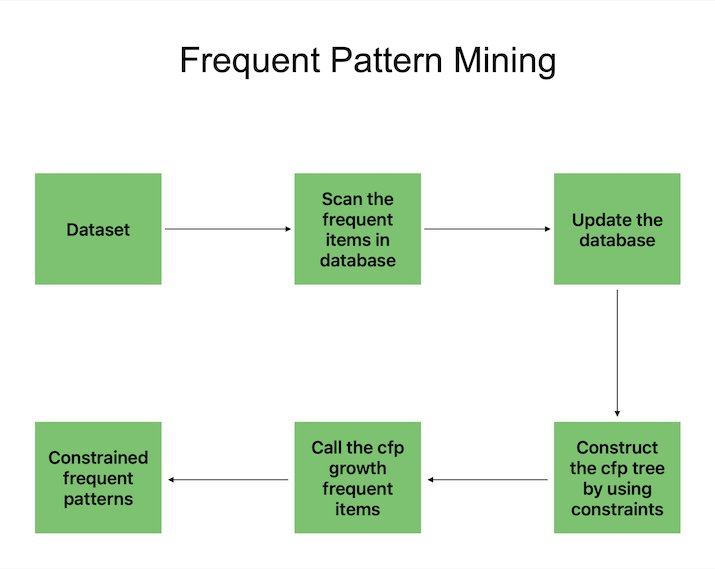
 Data Structure
Data Structure Networking
Networking RDBMS
RDBMS Operating System
Operating System Java
Java MS Excel
MS Excel iOS
iOS HTML
HTML CSS
CSS Android
Android Python
Python C Programming
C Programming C++
C++ C#
C# MongoDB
MongoDB MySQL
MySQL Javascript
Javascript PHP
PHP
- Selected Reading
- UPSC IAS Exams Notes
- Developer's Best Practices
- Questions and Answers
- Effective Resume Writing
- HR Interview Questions
- Computer Glossary
- Who is Who
Frequent Pattern Mining in Data Mining
Finding recurrent patterns or item sets in huge datasets is the goal of frequent pattern mining, a crucial data mining approach. It looks for groups of objects that regularly appear together in order to expose underlying relationships and interdependence. Market basket analysis, web usage mining, and bioinformatics are a few areas where this method is important.
It helps organizations comprehend client preferences, optimize cross?selling tactics, and improve recommendation systems by revealing patterns of consumer behavior. By examining user navigational habits and customizing the browsing experience, online use mining aids in enhancing website performance. We'll examine frequent pattern mining in data mining in this piece. Let's begin.
Basic Concepts in Frequent Pattern Mining
The technique of frequent pattern mining is built upon a number of fundamental ideas. The analysis is based on transaction databases, which include records or transactions that represent collections of objects. Items inside these transactions are grouped together as itemsets.
The importance of patterns is greatly influenced by support and confidence measurements. Support quantifies how frequently an itemset appears in the database, whereas confidence quantifies how likely it is that a rule generated from the itemset is accurate.
The Apriori algorithm, a popular method for finding recurrent patterns, takes a methodical approach. In order to find no more frequent itemsets, it generates candidate itemsets, prunes the infrequent ones, and then progressively grows the size of the itemsets. The patterns that fulfill the required support criteria are successfully identified through this iterative approach.

Techniques for Frequent Pattern Mining
Apriori Algorithm
One of the most popular methods, the Apriori algorithm, uses a step?by?step procedure to find frequent item sets. It starts by creating candidate itemsets of length 1, determining their support, and eliminating any that fall below the predetermined cutoff. The method then joins the frequent itemsets from the previous phase to produce bigger itemsets repeatedly.
Once no more common item sets can be located, the procedure is repeated. The Apriori approach is commonly used because of its efficiency and simplicity, but because it requires numerous database scans for big datasets, it can be computationally inefficient.
FP?growth Algorithm
A different strategy for frequent pattern mining is provided by the FP?growth algorithm. It creates a small data structure known as the FP?tree that effectively describes the dataset without creating candidate itemsets. The FP?growth algorithm constructs the FP?tree recursively and then directly mines frequent item sets from it.
FP?growth can be much quicker than Apriori by skipping the construction of candidate itemsets, which lowers the number of runs over the dataset. It is very helpful for sparse and huge datasets.
Eclat Algorithm
Equivalence Class Clustering and bottom?up Lattice Traversal are the acronyms for the Eclat algorithm, a well?liked frequent pattern mining method. It explores the itemset lattice using a depth?first search approach, concentrating on the representation of vertical data formats.
Transaction identifiers (TIDs) are effectively used by Eclat to locate intersections between item sets. This technique is renowned for its ease of use and little memory requirements, making it appropriate for mining frequent itemsets in vertical databases.
Applications of Frequent Pattern Mining
Market Basket Analysis
Market basket analysis frequently mines patterns to comprehend consumer buying patterns. Businesses get knowledge about product associations by recognizing itemsets that commonly appear together in transactions. This knowledge enables companies to improve recommendation systems and cross?sell efforts. Retailers can use this program to assist them in making data?driven decisions that will enhance customer happiness and boost sales.
Web usage mining
Web usage mining is examining user navigation patterns to learn more about how people use websites. In order to personalize websites and enhance their performance, frequent pattern mining makes it possible to identify recurrent navigation patterns and session patterns. Businesses can change content, layout, and navigation to improve user experience and boost engagement by studying how consumers interact with a website.
Bioinformatics
The identification of relevant DNA patterns in the field of bioinformatics is made possible by often occurring pattern mining. Researchers can get insights into genetic variants, illness connections, and drug development by examining big genomic databases for recurrent patterns. In order to diagnose diseases, practice personalized medicine, and create innovative therapeutic strategies, frequent pattern mining algorithms help uncover important DNA sequences and patterns.
Conclusion
In conclusion, frequent pattern mining is a fundamental method for data mining that focuses on identifying recurrent patterns in sizable datasets. This method finds hidden dependencies and relationships by recognizing groups of elements that regularly co?occur. The value of frequent pattern mining is found in its capacity to offer insightful data for data?driven decision?making.
It lets companies comprehend consumer behavior, enhance cross?selling tactics, customize user experiences, and arrive at well?informed decisions across a variety of industries, including bioinformatics, retail, and online usage analysis. In today's data?driven world, organizations can more effectively exploit data, improve decision?making procedures, and gain a competitive edge by extracting regular patterns.

